The ASUS Zenbook UX305 Review
by Brett Howse on March 25, 2015 8:00 AM ESTSystem Performance
ASUS has employed the Intel Core M processor in the design of the UX305, and unlike the first device we tested with Core M, ASUS has created the UX305 as a fanless design. This is likely easier to achieve when you consider that the UX305 is completely constructed out of aluminum. Aluminum is a great conductor of heat, and allows a big part of the laptop to be a cooling surface. The heat is also kept at the top of the keyboard deck, where it is less likely to be noticed when using the laptop. During most general use of the UX305, it does not get warm anyway, and only when used for extended periods of high use did I notice it get hot.
The UX305 will be offered with either the Core M-5Y10 or 5Y71 processors, although for North America the 5Y10 is the only available processor right now. It is a dual-core, quad-thread CPU with an 800 MHz base frequency, and 2 GHz boost frequency. This is a big step down from the 5Y71 which has a 1.2 GHz base and 2.9 GHz boost capability, so it will be interesting to see how the UX305 performs. I have highlighted the Lenovo Yoga 3 Pro since it is the only other Core M device we have tested, and it has the Core M-5Y71 processor onboard.
To compare the performance, I have selected a sampling of devices that we have tested which are roughly the same class of device. To compare the UX305 to any other device we have tested, please use our Notebook Bench.
PCMark
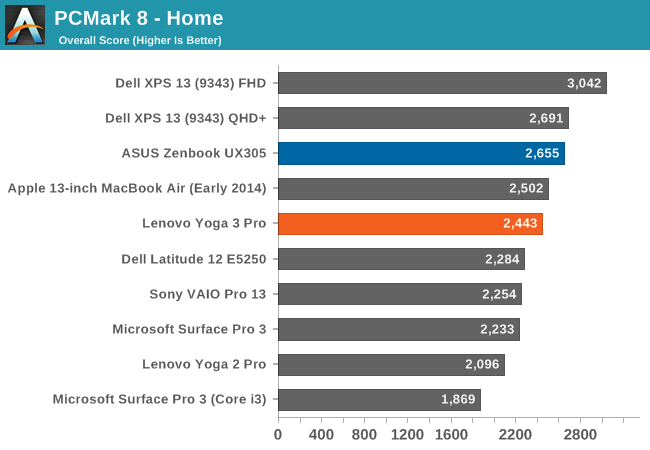
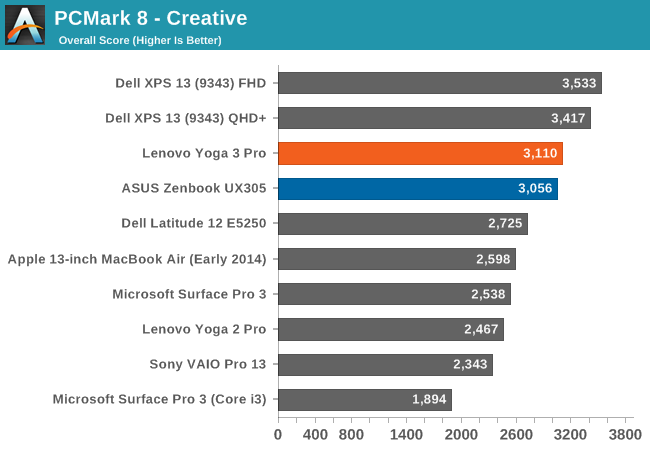
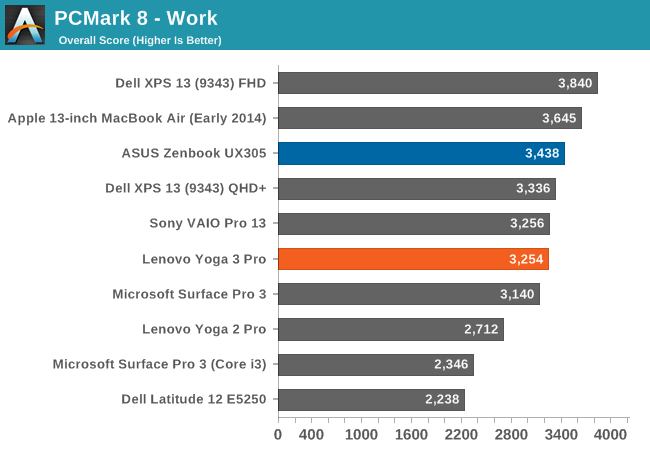
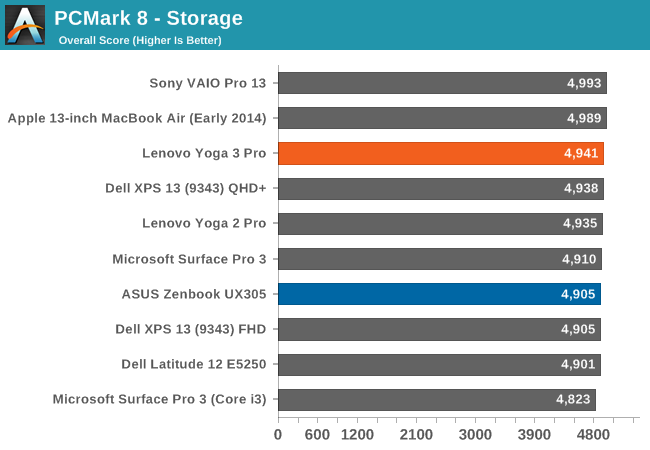
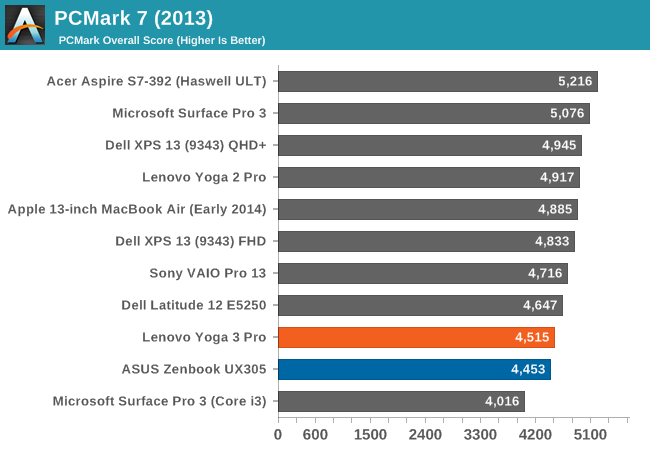
PCMark 8 performs four sets of tests, with different use case scenarios to get a feel for how the device will perform on several different sets of tasks. The UX305 performs quite well here, despite the Core M processor. You can see that it even outperforms the Yoga 3 Pro on several of the tests, and it has a faster version of the Core M CPU. We will dig into that more in a bit.
Cinebench and x264
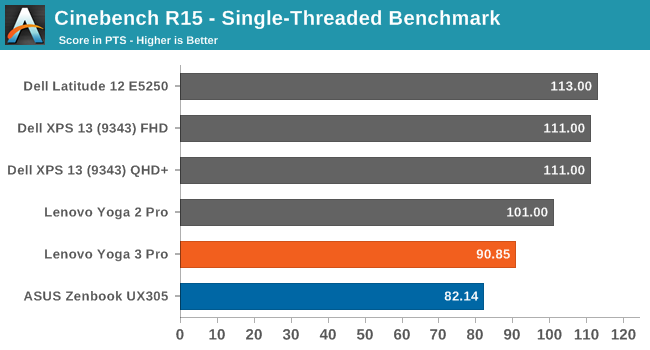
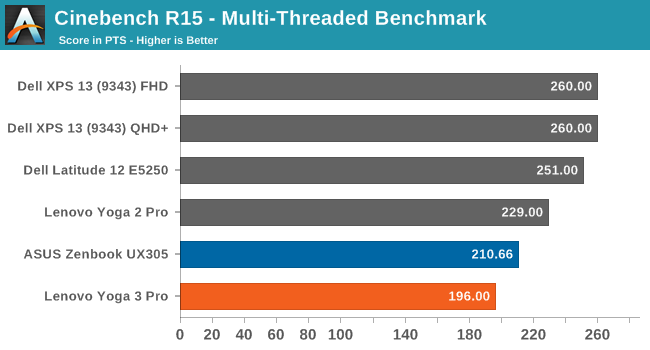

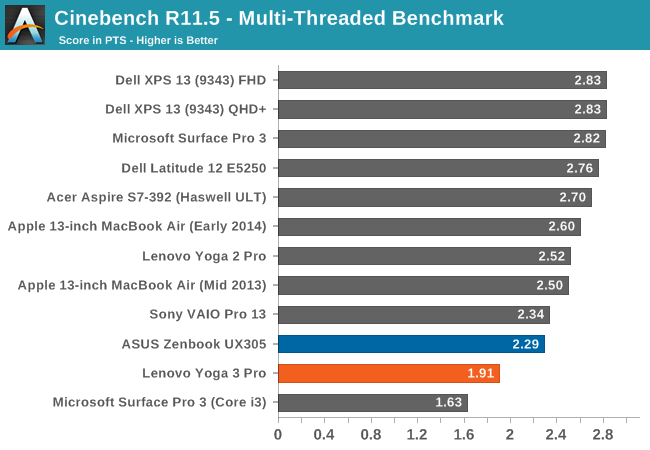
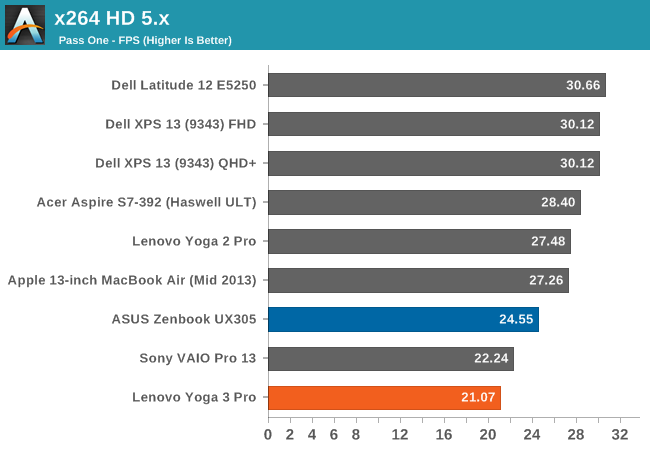
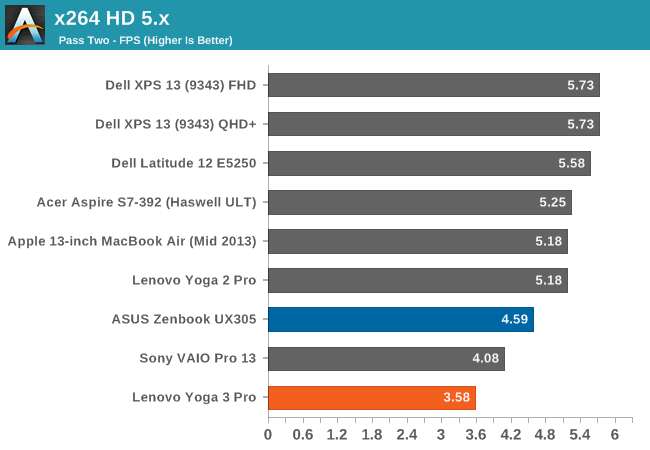
On the single-threaded runs of Cinebench, The UX305 is near the bottom of the pack. That is unsurprising, since it has a boost clock of just 2 GHz, and furthermore on a single-threaded runs most CPUs can usually perform very close to their boost clock for the duration. Consequently the extra 900 MHz on the Yoga 3 Pro's 5Y71 pulls a big lead here. It is interesting to note that the only Haswell-Y based processor that was in Bench was the Core i3 version of the Surface Pro 3. Broadwell-Y (Core M) handily outperforms it in both single and multi-threaded workloads. This has a lot to do with the Core i3 having no boost clocks at all.
Moving on to the Multi-threaded workloads, we can see that the UX305 is still near the bottom of the chart, but it has passed the Yoga 3 Pro with 5Y71. The same thing occurs on the x264 benchmark, which lasts several hours. We need to see a couple of more benchmarks to get an idea of what is going on.
TouchXPRT 2014
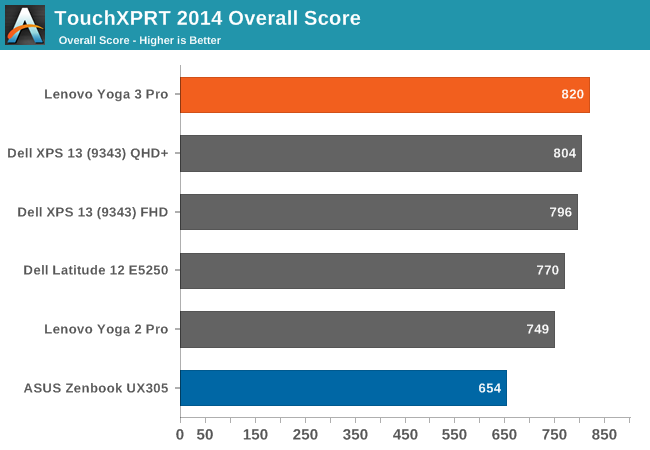

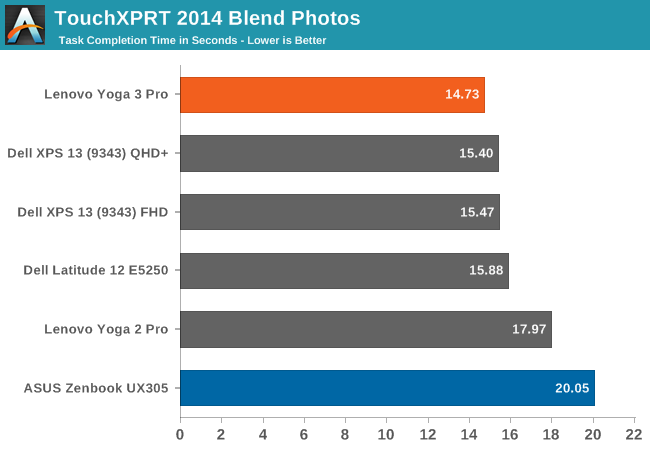
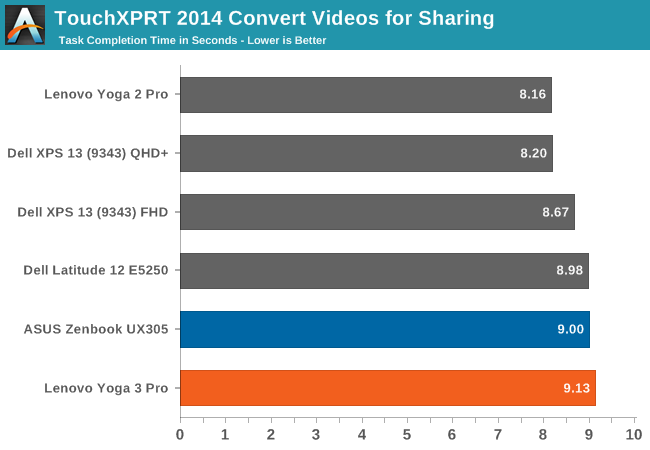
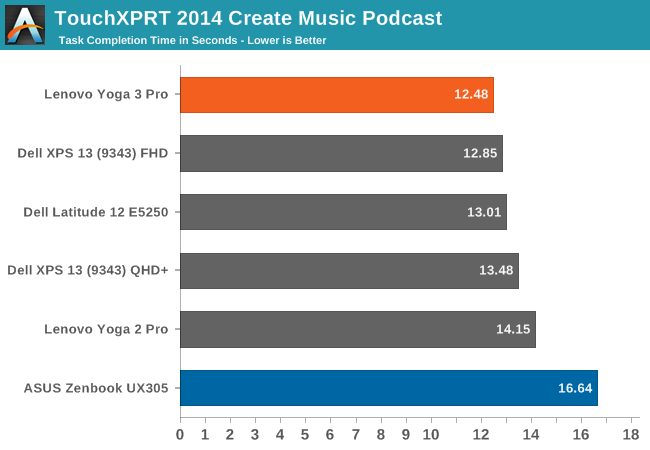
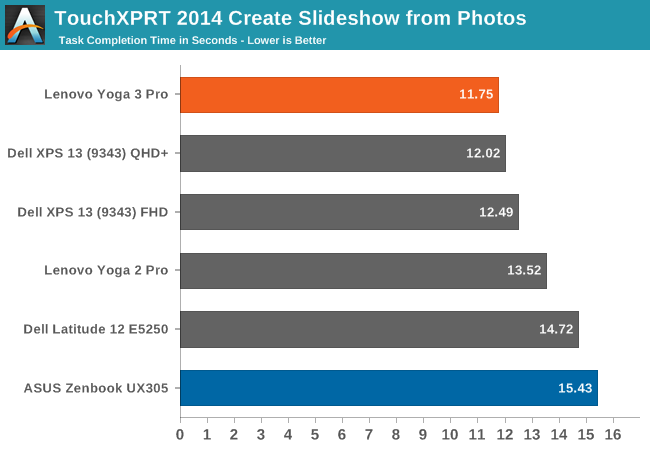
TouchXPRT is a Windows Store benchmark which performs several common tasks that someone at home may perform. All of the benchmarks result in a time to complete a task, which is then converted into an overall score. Here the UX305 plummets to the bottom of the charts, owing once again to its relatively low boost clock, scoring the lowest overall score of any device we have tested. The Yoga 3 Pro on the other hand with Core M 5Y71 and a 2.9 GHz boost clock has the highest overall score of any of the Ultrabooks in the chart. Once again we see a very different result from the previous test.
Web Benchmarks
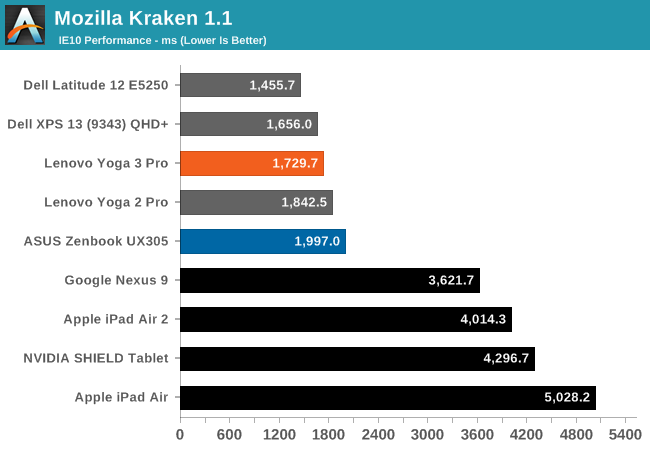

Running Javascript based browser benchmarks, the UX305 with Core M 5Y10 once again falls to the bottom of the chart. With just a 2 GHz boost clock, the 5Y10 struggles to compete against the likes of other laptops with faster Core M or U series processors. The ASUS UX305 cannot be converted into a tablet, but I have included some tablet benchmarks here just to show how Core M-5Y10 compares against the best performing tablets. With around the same power envelope, even the slowest Core M is still significantly faster than any tablet in CPU performance.
Explaining Core M Performance
On system performance, we have seen some fairly wild swings when comparing the UX305 with the slowest Core M processor available to other devices, especially the Yoga 3 Pro which has the fastest Core M released so far with the 5Y71. The Yoga 3 Pro even includes a fan, whereas the UX305 is passively cooled. On quick, burst benchmarks such as TouchXPRT, and on single-threaded benchmarks such as Cinebench, and even on the web tests the Yoga 3 Pro with 5Y71 offers a lot more performance. However on the longer benchmarks the UX305 pulls ahead despite the lower base and boost clock speeds.
Traditionally, it was just a given that higher numbered processors of the same processor family would give you better performance, but with the kind of devices Core M is being integrated into, that is not the case at all. There are a lot more factors at play when you look at Core M as a whole in order to understand where the performance level is going to be. For example, ASUS has opted to allow the processor to get much hotter, which then translates to higher surface temperatures on the device, especially since it is passively cooled. But this lets Core M keep its clock speeds higher when performing extended workloads. Lenovo on the other hand, even with a fan, has opted to keep the CPU temperature much lower, but that forces the CPU to throttle down under extended workloads. On a long test, the ASUS CPU hit as high as 80°C, but the Lenovo kept the CPU to around 60°C, and due to the fan, the surface temps of the laptop did not get warm very much at all.
The performance of Core M is much more akin to how a smartphone or tablet is limited in performance, where the manufacturer has to look at overall device temperatures and decide where they want to limit performance. ASUS has chosen a much more aggressive temperature, and it does not affect the device use very much because it is a laptop, and therefore can be used on a desk. You do not have to hold the device, so even though it can get to over 47°C (117°F) between the display and the top of the keyboard, the palm rests and keyboard never get warm at all. The aluminum chassis comes into play and can act as a large heat sink. Lenovo has chosen a much lower device temperature, but the Yoga 3 Pro is a convertible and can be used as a tablet, so having such a high surface temperature would be a big issue. Of course, if you are using the UX305 in your lap, it would be very uncomfortable as well, so watch out for that. For general tasks, the device does not get warm, but if you are doing extended heavy workloads, it can be an issue.
One such task which causes heavy use for extended times is gaming, so next up is GPU performance.










164 Comments
View All Comments
Calista - Wednesday, March 25, 2015 - link
Well, for a lot of people a Core 2 Duo is more than powerful enough. Using a M4400 with a Core 2 Duo T9600 from time to time rarely does it feel slow for "normal usage", i.e. browsing the web, working with Photoshop and whatnot.Once we have reached a certain threshold more performance just doesn't seem so important any more. I would say most folks reached that threshold with the release of the later C2D CPU:s.
FlushedBubblyJock - Wednesday, March 25, 2015 - link
I know many of these people, and replacing the spindle drive with a small SSD (and my usual optimizations in 5 mins) settles it entirely for them.It's faster than the new regulars at the stores.
TheWrongChristian - Thursday, March 26, 2015 - link
I just "upgraded" from my Core Duo T2400 based laptop (which kept up with modern software) to a $60 second hand thinkpad t61, with Core 2 T7100 CPU (which easily keeps up with modern software.)I only upgraded because the screen backlight on the old laptop was a bit flaky, and only upgraded to the thinkpad because it has a fantastic keyboard and I already had the ultrabay HDD adaptor from a previous work laptop, as well as using the same PSU as my old laptop (also a Lenovo.)
Modern machines are let down by their crappy keyboards and screens. That's where the race to the bottom has hit.
TL;DR
I concur. With the push of software down to tablet and smartphones, people have learned to somewhat optimize again, and CPUs performance from ~7-8 years ago is perfactly adequate.
akdj - Saturday, March 28, 2015 - link
Except I'd argue your two biggest concerns (keyboard and screen) are ..at least ½ of the equation ... Of MUCH higher quality, legibility, brightness, contrast, and their corresponding technologies behind them; AMOLED or LCS have come leaps and bounds in the last half to full decade. I'm also intrigued by the new keyboard and trackpad Apple has implementedIf anything, it does seem more Window's OEMs are getting trackpads correct. I can't speak to their keyboards but I've been using solely OS X laptops during that time period you're talking about. Though, during that period Apple's keyboards, again, have only gotten 'Better'. Just MHO, but not a lot of laptops are upgradable either, some 32bit even limited to 3-3.5GB of RAM & nearly impossible to get an SSD inside. That, the SSD today is the ONE differentiator and bottle neck eliminator we've seen. Not the CPU, the RAM, the display or the keyboard. GPU in some cases, sure. But going solid state and fanless without the need for AC all day...for the layman, those are HUGE wins
BrokenCrayons - Thursday, March 26, 2015 - link
I completely agree with the C2D being adequate. For me, "adequate performance" was an upgraded Dell Latitude D620 with a T2300 (1.6 GHz 32-bit dual core), 4 GB of RAM which wasn't fully utilized due to the 32-bit OS and a thing about the 945 chipset that didn't recognize more than like 3.2 GB and a 320 GB non-SSD. It was and still is just fine but the battery was bad, the screen was getting kinda flickery and one of the USB ports was damaged so I bought a used Latitude E6320 with some kind of i5 Sandy Bridge in it and it's far more than I need. While I like the fanless aspects of modern laptops, I hate the short key travel and other sacrifices made in the name of making something thin. It seems pointless and faddish to do that because the laptop still needs just as much space in a handbag or whatever since the other two dimensions aren't different. I'm sure that some people will want something like this, but I can't find a reason to care that much about the thickness. I didn't care when I had a 90 MHz Pentium laptop (which was fanless...Texas Instruments Travelmate 5130..there was a heatsink and this huge heat spreader bar under the keyboard) and I don't worry about it now.074geodude - Wednesday, March 25, 2015 - link
CPU performance wise, no you will not be upgrading.But everything else - screen quality, resolution, thickness, weight, 8 GB RAM, 256 GB SSD, battery life (11+hours, try getting that out of a Core 2 Duo).
It's time to upgrade.
beehofer - Thursday, March 26, 2015 - link
The Core M might not stand much a of chance against the the U but they seem to have a purpose. I would very much like a review of the new more powerful Asus UX303LA which is sporting the 5200U. I got it from the microsoft store for 1300$ after adding a 1TB EVO 850 SSD. the screen is higher ppi than the newest 13 inch macbook pro retina with 8GB of Ram. You can't beat the bang for the buck. Battery life is the only disappointment so far.sonicmerlin - Monday, March 30, 2015 - link
Even the iPad Air 2 has a faster GPU than Core M.FwFred - Monday, June 15, 2015 - link
I'd say the GPUs trade blows, but the Core M has faster CPU, and the Asus has far more storage for an equivalent price.Novacius - Wednesday, March 25, 2015 - link
It's a shame that it hasn't keyboard backlighting and such a poor display calibration. Maybe they'll do better in future iterations. I'm very interested in a Skylake model.